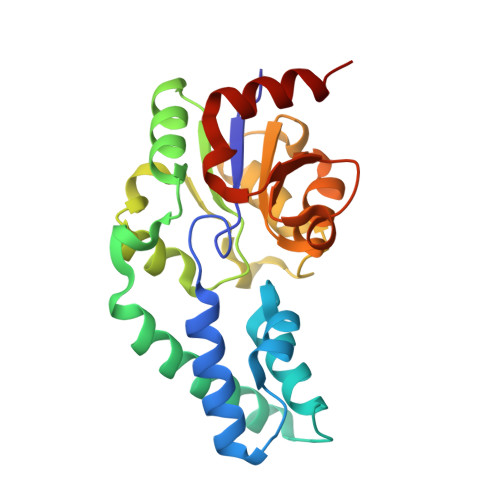Near Attack Conformers Dominate Beta-Phosphoglucomutase Complexes Where Geometry and Charge Distribution Reflect Those of Substrate.
Griffin, J.L., Bowler, M.W., Baxter, N.J., Leigh, K.N., Dannatt, H.R., Hounslow, A.M., Blackburn, G.M., Webster, C.E., Cliff, M.J., Waltho, J.P.(2012) Proc Natl Acad Sci U S A 109: 6910
- PubMed: 22505741
- DOI: https://doi.org/10.1073/pnas.1116855109
- Primary Citation of Related Structures:
2WF8, 2WF9, 2WFA - PubMed Abstract:
Experimental observations of fluoromagnesate and fluoroaluminate complexes of ¦Â-phosphoglucomutase (¦Â-PGM) have demonstrated the importance of charge balance in transition-state stabilization for phosphoryl transfer enzymes. Here, direct observations of ground-state analog complexes of ¦Â-PGM involving trifluoroberyllate establish that when the geometry and charge distribution closely match those of the substrate, the distribution of conformers in solution and in the crystal predominantly places the reacting centers in van der Waals proximity. Importantly, two variants are found, both of which satisfy the criteria for near attack conformers. In one variant, the aspartate general base for the reaction is remote from the nucleophile. The nucleophile remains protonated and forms a nonproductive hydrogen bond to the phosphate surrogate. In the other variant, the general base forms a hydrogen bond to the nucleophile that is now correctly orientated for the chemical transfer step. By contrast, in the absence of substrate, the solvent surrounding the phosphate surrogate is arranged to disfavor nucleophilic attack by water. Taken together, the trifluoroberyllate complexes of ¦Â-PGM provide a picture of how the enzyme is able to organize itself for the chemical step in catalysis through the population of intermediates that respond to increasing proximity of the nucleophile. These experimental observations show how the enzyme is capable of stabilizing the reaction pathway toward the transition state and also of minimizing unproductive catalysis of aspartyl phosphate hydrolysis.
Organizational Affiliation:
Department of Molecular Biology and Biotechnology, Krebs Institute, University of Sheffield, Sheffield S10 2TN, United Kingdom.





















